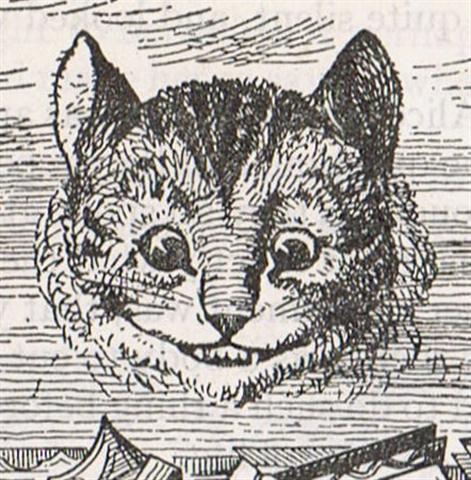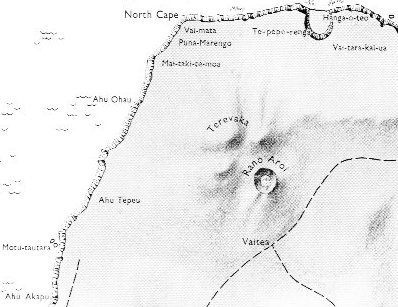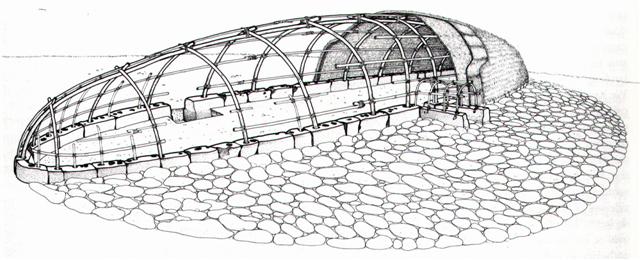7. Enters Tuu Ko Ihu: Ure sat out and caught eels, lobsters, and morays. He procured a great number (? he ika) of chickens, yams, and bananas and piled them up (hakatakataka) for the banquet to celebrate the new house. He sent a message to King Tuu Ko Ihu to come to the banquet for the new house in Vai Matā. A foster child (maanga hangai) of Ure Honu was the escort (hokorua) of the king at the banquet and brought the food for the king, who was in the house. The men too came in groups and ate outside. When Tuu Ko Ihu had finished his dinner, he rested. At that time he saw the skull hanging above, and the king was very much amazed. Tuu Ko Ihu knew that it was the skull of King Hotu A Matua, and he wept. This is how he lamented: 'Here are the teeth that ate the turtles and pigs (? kekepu) of Hiva, of the homeland!'
After Tuu Ko Ihu had reached up with his hands, he cut off the skull and put it into his basket. Out (went) the king, Tuu Ko Ihu, and ran to Ahu Tepeu.
He had the skull with him. King Tuu Ko Ihu dug a hole, made it very deep, and let the skull slide into it. Then he cushioned the hole with grass and put barkcloth on top of it, covered it with a flat slab of stone (keho), and covered (everything) with soil. Finally, he put a very big stone on top of it, in the opening of the door, outside the house. Ure Honu looked around for his skull. It was no longer in the house. When he questioned those who knew, the foster child of Ure Honu said, 'On the day on which the banquet for the new house was held, Tuu Ko Ihu saw the skull. He was very much moved and wept, 'Here are the teeth that ate the turtles and the pigs (? kekepu) of Hiva, of the homeland!' When the foster child of Ure Honu had spoken, Ure Honu grew angry. He secretly called his people, a great number of men, to conduct a raid (he uma te taua). Ure set out and arrived in front of the house of Tuu Ko Ihu. Ure said to the king, 'I (come) to you for my very large and very beautiful skull, which you took away on the day when the banquet for the new house was held. Where is the skull now?' (whereupon) Tuu Ko Ihu replied, 'I don't know.' When Tuu Ko Ihu came out and sat on the stone underneath which he had buried the skull, Ure Honu shot into the house like a lizard. He lifted up the one side of the house. Then Ure Honu let it fall down again; he had found nothing. Ure Honu called, 'Dig up the ground and continue to search!' The search went on. They dug up the ground, and came to where the king was. The king (was still) sitting on the stone. They lifted the king off to the side and let him fall. They lifted up the stone, and the skull looked (at them) from below. They took it, and a great clamour began because the skull had been found. Ure Honu went around and was very satisfied. He took it and left with his people. Ure Honu knew that it was the skull of the king (puoko ariki). To lift away the king and let him fall has an obvious symbolic meaning - he is king no more, he has been dethroned. When Ure Honu lifted the side of the house of Tuu Ko Ihu to look inside it was like letting spring light enter. The hare paega houses on Easter Island were built like overturned canoes, and an overturned canoe is like the sky dome of the night, signifying a dormant season. Picture from Van Tilburg, Easter Island. Archeology, Ecology and Culture:
The house was used to sleep in: The most vivid description of hut interiors is given by Eyraud ... who slept in them several nights: Imagine a half open mussel, resting on the edge of its valves and you will have an idea of the form of that cabin. Some sticks covered with straw form its frame and roof. An oven-like opening allows its inhabitants to go inside as well as the visitors who have to creep not only on all fours but on their stomachs. This indicates the center of the building and lets enter enough light to see when you have been inside for a while. You have no idea how many Kanacs may find shelter under that thatch roof. It is rather hot inside, if you make abstraction of the little disagreements caused by the deficient cleanliness of the natives and the community of goods which inevitably introduces itself ... But by night time, when you do not find other refuge, you are forced to do as others do. Then everybody takes his place, the position being indicated to each by the nature of the spot. The door, being in the center, determines an axis which divides the hut into two equal parts. The heads, facing each other on each side of that axis, allow enough room between them to let pass those who enter or go out. So they lie breadthwise, as commodiously as possible, and try to sleep. (Alfred Métraux, Ethnology of Easter Island.) |


